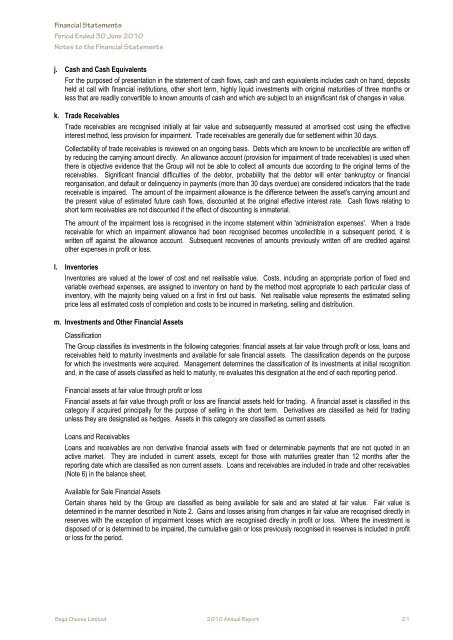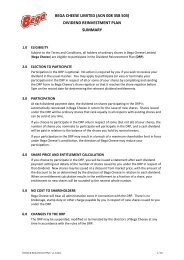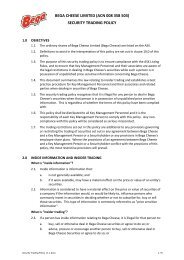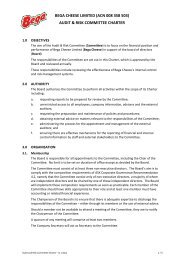Annual Report - Bega Cheese
Annual Report - Bega Cheese
Annual Report - Bega Cheese
Create successful ePaper yourself
Turn your PDF publications into a flip-book with our unique Google optimized e-Paper software.
Financial Statements<br />
Financial Period Ended Statements 30 June 2010<br />
Period Notes to Ended the Financial 30 June 2010 Statements<br />
Notes to the Financial Statements<br />
j. Cash and Cash Equivalents<br />
For the purposed of presentation in the statement of cash flows, cash and cash equivalents includes cash on hand, deposits<br />
held at call with financial institutions, other short term, highly liquid investments with original maturities of three months or<br />
less that are readily convertible to known amounts of cash and which are subject to an insignificant risk of changes in value.<br />
k. Trade Receivables<br />
Trade receivables are recognised initially at fair value and subsequently measured at amortised cost using the effective<br />
interest method, less provision for impairment. Trade receivables are generally due for settlement within 30 days.<br />
Collectability of trade receivables is reviewed on an ongoing basis. Debts which are known to be uncollectible are written off<br />
by reducing the carrying amount directly. An allowance account (provision for impairment of trade receivables) is used when<br />
there is objective evidence that the Group will not be able to collect all amounts due according to the original terms of the<br />
receivables. Significant financial difficulties of the debtor, probability that the debtor will enter bankruptcy or financial<br />
reorganisation, and default or delinquency in payments (more than 30 days overdue) are considered indicators that the trade<br />
receivable is impaired. The amount of the impairment allowance is the difference between the asset's carrying amount and<br />
the present value of estimated future cash flows, discounted at the original effective interest rate. Cash flows relating to<br />
short term receivables are not discounted if the effect of discounting is immaterial.<br />
The amount of the impairment loss is recognised in the income statement within 'administration expenses'. When a trade<br />
receivable for which an impairment allowance had been recognised becomes uncollectible in a subsequent period, it is<br />
written off against the allowance account. Subsequent recoveries of amounts previously written off are credited against<br />
other expenses in profit or loss.<br />
l. Inventories<br />
Inventories are valued at the lower of cost and net realisable value. Costs, including an appropriate portion of fixed and<br />
variable overhead expenses, are assigned to inventory on hand by the method most appropriate to each particular class of<br />
inventory, with the majority being valued on a first in first out basis. Net realisable value represents the estimated selling<br />
price less all estimated costs of completion and costs to be incurred in marketing, selling and distribution.<br />
m. Investments and Other Financial Assets<br />
Classification<br />
The Group classifies its investments in the following categories: financial assets at fair value through profit or loss, loans and<br />
receivables held to maturity investments and available for sale financial assets. The classification depends on the purpose<br />
for which the investments were acquired. Management determines the classification of its investments at initial recognition<br />
and, in the case of assets classified as held to maturity, re evaluates this designation at the end of each reporting period.<br />
Financial assets at fair value through profit or loss<br />
Financial assets at fair value through profit or loss are financial assets held for trading. A financial asset is classified in this<br />
category if acquired principally for the purpose of selling in the short term. Derivatives are classified as held for trading<br />
unless they are designated as hedges. Assets in this category are classified as current assets.<br />
Loans and Receivables<br />
Loans and receivables are non derivative financial assets with fixed or determinable payments that are not quoted in an<br />
active market. They are included in current assets, except for those with maturities greater than 12 months after the<br />
reporting date which are classified as non current assets. Loans and receivables are included in trade and other receivables<br />
(Note 6) in the balance sheet.<br />
Available for Sale Financial Assets<br />
Certain shares held by the Group are classified as being available for sale and are stated at fair value. Fair value is<br />
determined in the manner described in Note 2. Gains and losses arising from changes in fair value are recognised directly in<br />
reserves with the exception of impairment losses which are recognised directly in profit or loss. Where the investment is<br />
disposed of or is determined to be impaired, the cumulative gain or loss previously recognised in reserves is included in profit<br />
or loss for the period.<br />
<strong>Bega</strong> <strong>Cheese</strong> Limited 2010 <strong>Annual</strong> <strong>Report</strong> 21<br />
<strong>Bega</strong> <strong>Cheese</strong> Limited 2010 <strong>Annual</strong> <strong>Report</strong> 21












